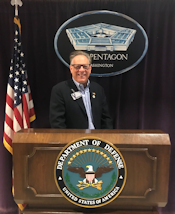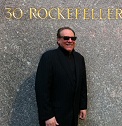COFES Institute Interview with Joel Orr, Co-Founder of COFES
Posted on January 18th, 2018 | No Comments »

COFES Institute Interview with Joel Orr, Co-Founder of COFES
January 2018
 Today we are proud to share our third COFES Institute newsletter, with our interview of Joel Orr, Co-Founder of COFES.
Today we are proud to share our third COFES Institute newsletter, with our interview of Joel Orr, Co-Founder of COFES.
Steve Waite: It is wonderful to speak with you today, Joel. Tell us about the genesis of COFES and what you were hoping to achieve with the event as a co-founder.
Joel Orr: We were driving to the airport after the NDES show – the National Design Engineering Show – in 1999. We all noticed the same thing at the show. All the interesting conversations happened in the hallways. So we decided to try to create an event that would be mostly hallways. The back room discussions, so to speak, became front and center. That was our genesis and that is what we have attempted to achieve with COFES.
SW: Excellent! You have a long, distinguished career in CAD. Take us back to the early days and tell us what you saw.
JO: I got into the technology of CAD at my last W-2 job. I was Systems Manager for the computer department of Nashville, Tennessee. I was in charge of creating one of the first municipal geographic information systems in 1973. From there, I became a consultant and did similar projects in various cities in the US, as well as in Israel.
There was an emerging trend where companies were investing more money into electronic, mechanical and architectural design than they were putting into mapping. Because of my familiarity with the technologies, I took a role in more general CAD while staying involved in mapping. That gave me a very broad kind of outlook. I’m a techno-dilettante. That is someone who is an inch deep and a mile wide in all of these areas.
SW: What was a conventional CAD system like back in the 1970s?
JO: CAD systems in the ‘70s were something that cost in the neighborhood of $100,000 per seat, at a time when a senior engineer was making $20,000 per year. Before purchasing a system like that, companies wanted to get some assurance that if they bought one, they wouldn’t be sorry. Paying a consultant $5,000 to spend some time helping them understand the nature of their issues and what might be useful was a good deal for them. Everything evolved from there.
SW: What were the key factors in evaluating whether a CAD system made sense for a company back in the 70s?
 JO: Most issues in large companies are people issues, not technology issues. Early on in the game, people were dazzled by the technology. It seemed magical. There was no way it could fail. I would bring a little bit of a wet blanket to the promises of the CAD sales people and teach my clients about the right questions to ask and who to ask them of. Every CAD vendor had some success stories. Early on, I realized that most benchmarks are staged affairs. I focused on interviewing CAD users to get around the staging issue.
JO: Most issues in large companies are people issues, not technology issues. Early on in the game, people were dazzled by the technology. It seemed magical. There was no way it could fail. I would bring a little bit of a wet blanket to the promises of the CAD sales people and teach my clients about the right questions to ask and who to ask them of. Every CAD vendor had some success stories. Early on, I realized that most benchmarks are staged affairs. I focused on interviewing CAD users to get around the staging issue.
SW: That is interesting. I was part of a team with Gideon Gartner and one of his protégés that did something similar back in the early 2000s. I didn’t realize you were a pioneer in this area. Where did interviewing CAD users take you? What kind of opportunities emerged from that approach?
JO: That work with users led to consulting with CAD vendors. My contacts with the clients were useful to the vendors. I had established a reputation as an independent consultant that could not be bought. They would bring me in to educate the client in general or for discussion. That became a good part of my business as well. I worked with both users and vendors.
SW: So you developed a model that allowed you to work with both CAD users and vendors without any conflicts of interest. Is that a correct statement?
JO: Yes it is.
SW: That is an admirable business model. From your grand perspective of collaborating closely with both users and vendors, what is the primary value add of a CAD system?
JO: The essence of the engineering is that it is a non-deterministic process. That is, having a set of initial conditions, you cannot accurately predict the final conditions. The dynamic that drives this process is trial and error. You try something. You tweak it and fiddle with it. You hope that your fiddling converges – that it gets closer to the ideal. That in and of itself is not guaranteed either. The essence of CAD is to build models more quickly and more precisely than you can in any other way. That is how CAD happened.
SW: So the primary value of CAD is speed and precision within an engineering process that is non-deterministic.
JO: Yes, that is correct. And there is another important element. With CAD, mistakes are cheap.
SW: Ahhh… it is easy to see the incredible value CAD brings to the table: Speed, precision and cheap mistakes.
JO: Yes. There was a time before CAD when getting the precise volume of something like a shampoo bottle was not a trivial exercise. It involved wooden models, creating a plastic mock up, and measuring the amount of liquid that could go in it. CAD was able to do this. You could specify by volume rather than having to experiment with physical models. CAD transformed the entire container industry.
 SW: Let’s fast forward to today. We’ve seen remarkable advances in technology hardware and software since the early 70s. We can do trial and error faster and more precise than ever. Engineers are using CAD systems today to design products at the nanometer level. What’s your perspective on CAD today?
SW: Let’s fast forward to today. We’ve seen remarkable advances in technology hardware and software since the early 70s. We can do trial and error faster and more precise than ever. Engineers are using CAD systems today to design products at the nanometer level. What’s your perspective on CAD today?
JO: We are designing semiconductors with circuitry so intricate and tiny that the human eye cannot see it. CAD enables this type of nano-engineering. This is all moving into the world of medicine. We are 3D printing kidneys today. You have to be able to manipulate very, very small things – things you cannot see.
SW: The designs and engineering enabled by CAD systems today are truly astonishing, bordering on science fiction in some cases. What kind of CAD-enabled future do you foresee based on current technological trends?
JO: In the mid-70s, my IBM salesman was my best friend. He said that IBM Labs had developed a simulation system that could predict the outcome of the World Series based on various data inputs. He said there was only one thing wrong with the system. It took three weeks to make the prediction. We know that the World Series doesn’t take three weeks to play, so that was a big problem. The fact that you can predict the outcome of an event like the World Series a week or two after the outcome wasn’t valuable.
SW: Things have sped up quite a bit since then!
JO: Yes, they have. Think about knowing what the outcome of the World Series is before it is over. We have computer systems today with that kind of power. That’s a game-changer. (Although I haven’t seen any World Series prediction systems that work yet, so the salesman may have been a bit over-confident…)
SW: That boggles the mind. What’s the role of the human designer and engineer in tomorrow’s CAD world – a world that is likely to be increasingly populated with AI, machine learning, virtual reality and other emerging technologies?
JO: That’s a good question. The way a friend of mine put it, there is no question that real AI is coming. But the real question is whether it will like us and keep us around.
SW: Well, that is a provocative statement and one that is likely to generate a great deal of discussion. Let’s table any further discussion for the upcoming COFES event. We’ll be talking a lot about human-aided design in a world of AI. Suffice it to say, the upcoming COFES event promises to be another great one!
JO: Yes, it does.
SW: It has been wonderful speaking with you today, Joel. Thank you for your time. We hope to see you at COFES 2018.

Steve Waite is a member of the COFES Institute Advisory Board. He is the author of several books, including Quantum Investing and Venture Investing in Science.
——————————
If you are interested in participating in COFES 2018, then please contact Vincent Caprio, President of COFES Institute vincent@cofes.org




